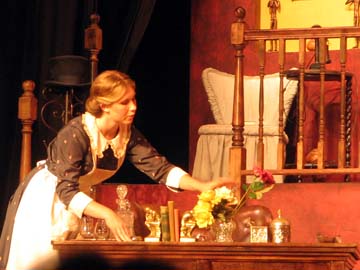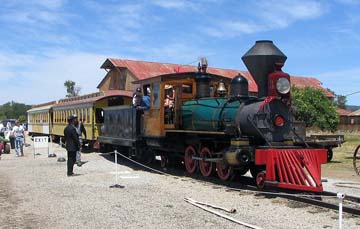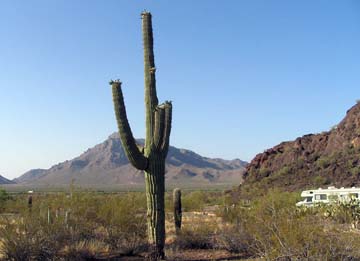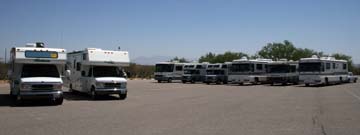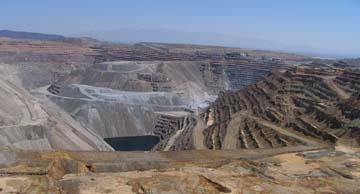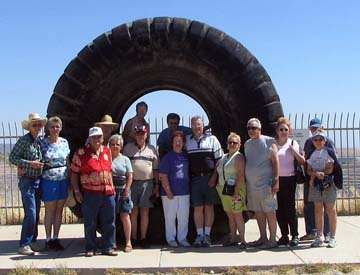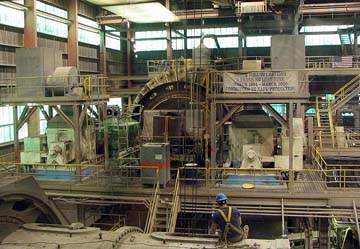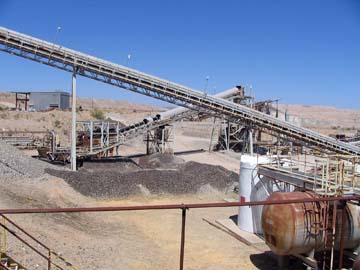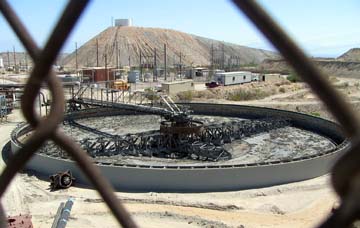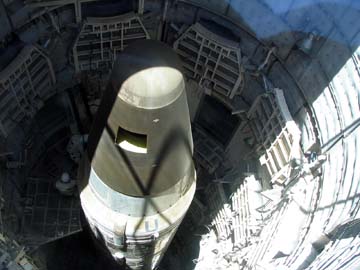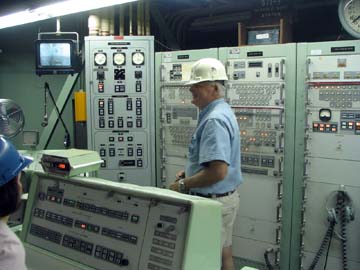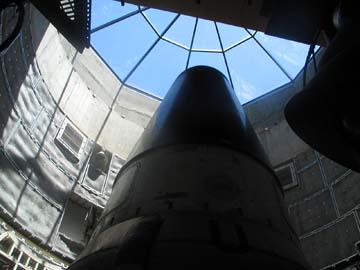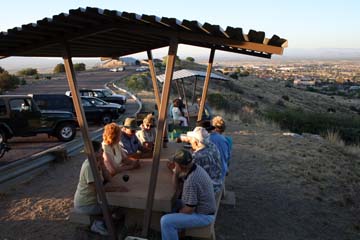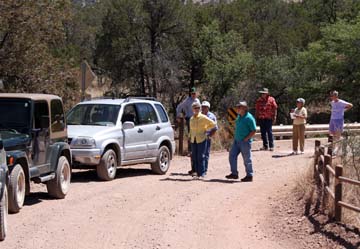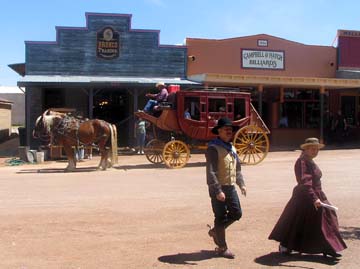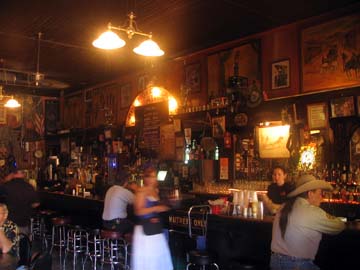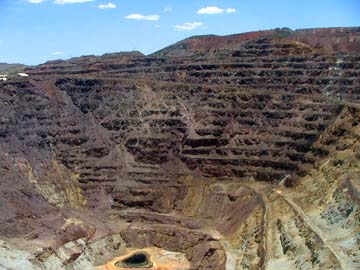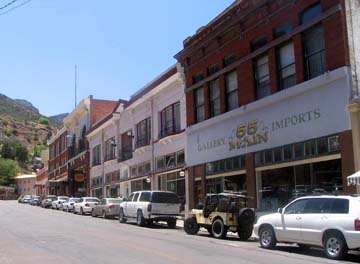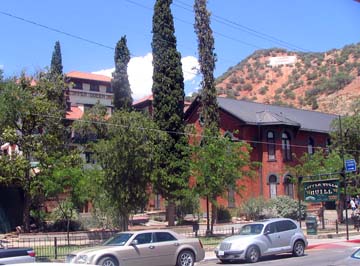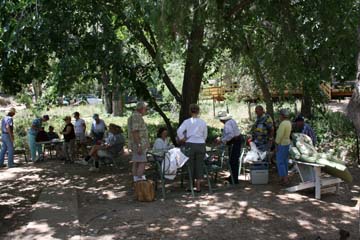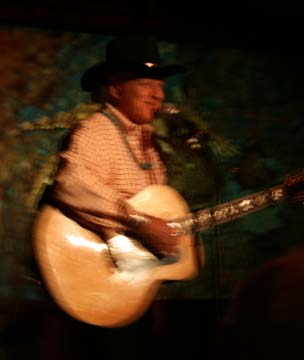| Hi all,
Well, I am off again! I will be with the Escondido First United Methodist Church RV group, the Ramblin' Recs for about a week. My good friend Rosemarie McBride will be with me. This trip was supposed to start at Campo, CA at the San Diego Railway Museum with a train ride to Tecate Mexico, a stay of several hours, and then a return trip to Campo. All our checks were sent to the museum in January to assure a place on the May trip. This train runs once a month, and fills up early. Unfortunately, the museum lost our checks and filled up the train without us. None of the checks have been cashed, and other than the receipt that shows they received them, no one knows what happened. As a result, I decided to skip the substitute campground in the Campo area and meet the group on day 3 at the Picacho Peak State Park Campground in southern Arizona. The group will move to Fort Huachuca, AZ for six nights, then on to Show Low Arizona for several days. I decided to skip the last stop, and head home after one week directly from Fort Huachuca. Non-Reported Recent Trips
Oct. Went to Casa Grande, AZ with the Sun Country Road Runners (SCRR) for a rally where we were responsible for driving all the trams transporting attendees to and from events. It was a lot of work and a lot of fun! Nov. Had a several-day rally in Cottonwood, AZ with the SCRR. Dec. Went to Escondido to see Debbie for Christmas and to take her to our annual Christmas Breakfast at Betty's neice's house with many other relatives. Mar. Went to a SCRR rally in Parker AZ for several days. May Went to Atascadero to visit David and family and
to see Kylie perform the part of the housekeeper in My Fair Lady.
It was an excellent production, and of course Kylie excelled in her part!
The next day, we went to Santa Margarita to the annual San Luis Obispo Train Museum open house and fund raiser. They had live steam trains and lots of exhibits. It was a lot of fun. The following day, Rosemarie and I went to Hearst Castle, saw their movie, and took a fascinating tour of the mansion and its grounds. It was a busy and fun trip. Now back to this trip!
Sunday, May 20, 2007 Picacho Peak State Park
As it turned out, the drive here was quite easy. We took Loop 101 east completely around the construction, coming back into I-10 well below the Phoenix mess. We had reservations at the group area of the park, which has no hookups,
as they make no reservations anywhere else. As I was signing in at
the park, my cell phone rang. It was Floyd Lamb, our wagonmaster.
He suggested I see if there were enough electric sites and change over
to them. There was only one RV in the camping loop which had electric
hookups, so it was no problem at all. Our 11 rigs filled less than
half the available spaces. It was MUCH better having electric hookups,
as we would have had to run our generators a lot to power our air conditioners.
It is 100 degrees here today!
Monday, May 21 Today was a relaxing one. It seemed quite a bit cooler today.
There were no planned activities. Rosemarie and I drove into Tuscon
and did some light shopping. The rest of the day was spent chatting
with the other people and loafing, and ended with a potluck dinner.
No one has ever left a Methodist potluck hungry!
Tuesday, May 22 We left camp at 8 AM (with Floyd in control, that is not 7:59 or 8:01, it is 8:00!) and headed for Fort Huachuca, about 165 miles south. Enroute, most of us planned to stop at the Asarco copper mine and then at the Titan Missile Museum. Asarco Copper Mine
Initially the mine was a series of tunnels. These would be dug until they hit a vein of rich copper. They would then dig to follow the veins. The ore removed from these veins were about 40 to 60% copper. As the copper veins were depleted, they transitioned to an open pit mine. Currently they are mining ore which contains 0.6% copper. To remove copper from the mine, they blast and collect the raw ore in sizes that range up to 5 feet across the rocks. A series of milling operations gradually reduces the size of the rocks to about 8 inches, then to about 4 inches, and eventually to a sand like consistency. Then by treating it with a series of chemicals which attach small bubbles to the copper particles, they float the copper in large tanks and scoop it off. This is a black fine sand product containing about 75% copper. This is the product the mine ships to other vendors for further refinement. Our 1 hour bus tour of the mine took us around much of the huge pit
which is over a mile wide and 2 plus miles long. It is about 1000
feet deep. We could see the huge shovels and massive trucks they
place the blasted rock in for transport to the milling operations.
They appeared very small at the distance we were from them. Everything
we saw was of a massive scale. The bus took us to the milling plant
they are currently redoing. They expect to be back in production
by the end of the year. Inside were massive ball mills, cone mills
and other rock reducing equipment. There are a minimum of two of
each type of mill, so there is always a backup in case of equipment failure.
After the copper has been removed, the fine sand residue is placed in a large concrete cylinder, with huge arms sweeping around where it is turned into a slurry which is pumped through hoses and sprayed out nozzles forming huge dike-type walls. They periodically move the hoses to form terraces. This is their disposal method for the tailings. When an area of tailings is finished, they eventually cover it with topsoil and grass seed. Eventually it will become typical desert landscape. To ensure that the mine will do this, the government holds $.16 for every pound of copper produced until the tailings are satisfactorily returned to native condition. Titan Missile Museum
We initially entered the new visitor center and bought our tickets.
As we had about 40 minutes to the tour, many of us went back to our RV's
and had lunch. The tour started with a video describing the purpose
of the Titan program and how it was implemented. There were three
clusters of sites. Southern Arizona was one of these locations.
After the video, we headed outside through a yard of antennas, radar based
security sensors, and miscellaneous equipment to a half-pyramid of glass
windows. This was directly over the nose cone of the missile in the
silo. The massive track mounted top door was concreted in a half
open position, and there were massive concrete stanchions which would prohibit
the door from opening even if it were not cemented. Our windows covered
the other half. Through these windows you could see all the way down
the side of the missile to the circular thrust ring at the bottom.
We were then herded through the access portal entrance. This was the only way in and out of the silo and the master control room. During the operational periods, the crew, which consisted of two officers and two enlisted men, had to call in on four separate phones to gain access along the way. Each would call and gain access to this door,then after descending the 55 steps down to the level of the control room, he would gain access through a massive blast door. While locked between two of these doors he would call and recite a daily code issued earlier. Then as a TV camera watched, he would burn the slip with the code and place it in a can mounted there for that purpose. Only then could he open the second blast door and enter the control area. The two doors could never be both open at the same time. Each crew was on station for a 24 hour duty. The control room was flanked by 6 or 8 racks of electronic equipment with a control console in the center and a smaller console off to its side. As you might imagine, security was very tight! There were very
sensitive radar detectors numerous places above ground. I already
mentioned the check-in procedures for the crew. Once in, the control
room and surrounding areas they were in a "no lone" zone. No one
was allowed to be out of eye contact with at least one other crew member
at any time - not even for a moment. The only area which did not
have this rule was in the personell quarters.
In the control room was a lock box with two locks. The Commander and Deputy Commander each arrived with their own locks. The first thing they did was to have the old crew open the box, they would inventory the contents, then the new crew would put their locks on. In the box were various codes and two keys. These keys were required to fire the missile. There was a system to verify that any order to fire came directly from the President. He was the only one authorized to permit the firing of one or more of the missiles. There were three targets programmed into the consoles. None of the crew knew the identities of any of these targets, only as targets 1, 2, or 3. If there were ever a command to fire, after the verification process a target number would be given and a many-digit code would have to be entered into one of the panels. This unit allowed only 6 false codes to be entered during its lifetime or it would self destruct. After accepting this code the consoles would be armed. One of the two keys from the lock box would be put in the Commander's console, the other in the Deputy Commander's console. To fire, these two keys, which were more than 6 feet apart, had to be simultaneously depressed and turned for 5 seconds. Once that was done, there was no turning back. The launch process was started by opening the cover door, all the guidance data was downloaded, all systems were automatically started, and within a minute the missile was streaking its way toward the designated target. There was no abort! There was no destruct option! It was going! Fortunately these missiles did exactly what they were designed to do. Nothing! They were a deterrent and were never needed to be fired. Fort Huachuca
The FamCamp at Fort Huachuca is very nice. There are hundreds
of concrete pads with full hookups and many beautiful green trees.
There is a good separation between coaches, so privacy is not a problem.
Wednesday, May 23 Today was a relaxing one, with only an evening potluck on the schedule. Rosemarie and I drove into Sierra Vista to do some light shopping and exploring. We were amazed by the size of this city! We then tried our first re-entry to the post by ourselves and had no problem! Museums
Across the street was the museum annex which contained a life size scene of a portion of a battle camp. It showed tents, soldiers, cannon, etc. Around the edges were numerous cases containing related items and artifacts. My favorite museum was the MI Museum (Military Intelligence Museum). This had many examples of communication, spying, and other intelligence gathering equipment. These included field telephone equipment, fake plants containing monitoring cameras, a drone aircraft which had made over 50 reconnisence flights, a pen which contained a hidden probe for gathering material samples, code wheel devices, etc. This evening, we headed up to a picnic area on a nearby hill and had
a potluck dinner. Actually, it was a "managed potluck", in that we
had taco salad and desert. It was great! The view was spectacular.
Thursday, May 24 Karchner Caverns
In November 1974 two young cavers, Gary Tenen and Randy Tufts, were
exploring the limestone hills at the base of the Whetstone Mountains. In
the bottom of a sinkhole they found a narrow crack leading into the hillside.
Warm, moist air flowed out, signaling the existence of a cave. After several
hours of crawling, they entered a pristine cavern.
During the four years of secret exploration, the discoverers realized that the cave's extraordinary variety of colors and formations must be preserved. The cave's existence became public knowledge in 1988 when its purchase was approved as an Arizona State Park. Extraordinary precautions have been taken during its development to conserve the cave's near-pristine condition. As caverns go, this is one of the smaller ones, with only about 2 or 3 miles of underground passages. There are a wide variety of cave formations and it is a very beautiful cave. This cave is a living cave. Most of the formations are still growing in the 68 degree, 98 % humidity atmosphere. Extrodinary measures have been taken to preserve them. All tour members are spray misted as they enter the cave to add moisture to their clothes and to wash off any lint that could collect in the cave. If anyone touches any of the formations during a tour, the tourguide marks the place with a piece of colored tape, and that locations is specifically cleaned by the nightly cleaning crew. This crew also washes the paths to remove any lint and debris that collect there. They have a diaily tour for which no reservations are made. If the humidity is high enough, they will conduct this tour, if not, they will not. All entrances are protected by gasket sealed multiple doors. We really enjoyed our tour. This evening, we had yet another potluck dinner. Yum!
Friday, May 25 There was a planned backroad tour today, which 8 of our members took.
It meandered through the hills, went over a high peak where they had a
spectacular almost 360 degree view, and ended up in the vicinity of Nogales
where they then took the highway home. We did not go on this trip,
but those who did raved about the beauty of the sights they saw.
Tombstone and Bisbee
Tombstone is still Tombstone. (Can you say "tourist trap"?), but it
was enjoyable. We walked the streets looking at all the shops, watched
the stagecoach and wagon rides drive by, and listened to the simulated
gunfight at the OK Corrall. We did not buy the tickets to go in and
watch it. After a couple of hours we walked back to the car and proceeded
to Bisbee.
Bisbee is a very interesting old copper mining town. It is largly built on the side of a hill (It somewhat reminds me of Jerome). The town was founded in 1880, and with the success of the mine became the largest city between San Francisco and St. Louis by the early 1900's. It was a highly cultured town, but was still ragged around the edges with miners and ladies of ill-repute. In 1908 most of the central business area burned to the ground. By 1910 it was mostly rebuilt with the buildings which still stand almost intact today. Today, Bisbee is largely an artist's colony, and the shops reflect this. After going out to look at the open pit Copper Queen Mine, which ceased
operation around 1975, we toured many of the shops. They have NOT
ceased operation!
Saturday, May 26 This morning I did a couple of things around the motorhome, and helped Dick Bartley remount their CB antenna which had broken during the previous owner's reign. Dick and Alice have a Foretravel similar to mine. I was happy to help. This will be our final full day with the group. After we leave in the morning, they will continue here at Ft. Huachuca for another day, then head to Show Low, AZ for several more days. Arizona Folklore Preserve
We arrived at the Preserve around 11:30 for a picnic. It was a
beautiful well shaded spot. We really enjoyed just sitting, chatting,
and of course, eating.
Dolan was very instrumental in creating and running the preserve. It is now entirely volunteer run with Dolan as the artist in residence. He takes no fee for his performances here. The theater is very intimate with 16 small round tables, each with 4
chairs. In addition to the 64 seats on the main floor, there is a
small balcony which can hold an additional 10 or 12 chairs.
The concert was marvelous! Dolan is a wonderful singer, comedian, story teller, and 12 string guitar player. He has written over 300 original songs; many are ballads about the history of Arizona. He was an original member of the New Christy Minstrials back in the '60's and has a Grammy from that period. In 1966 he was appointed the official state balladeer for Arizona. Some of the numbers he sang included: Ghost Riders in the Sky, Geronimo, Who's Gonna Run the Truck Stop in Tuba City When I'm Gone?, Wildfire - a history of the Rodeo-Chediski fire and a tribute the the brave firemen who conquered it, and the Ballad to Sheriff Joe - a tribute to the Maricopa County strict, level headed, contriversial Sheriff Joe Arpio. The concert lasted 1 1/2 hours, and we all wished it would continue for much longer. We started putting things away for the trip home in the morning.
Sunday, May 27 We finished getting the motorhome ready for travel, and pulled out at 7:55 on the six hour drive home. After an eventless trip, we arrived home safely, got the vehicles parked, and proceeded to collapse in easy chairs. It was a very enjoyable, active trip. It is always wonderful to see my long time friends again. Till next time, Dick Thanks to Doug Baker for allowing me to use several of his photos!
|
